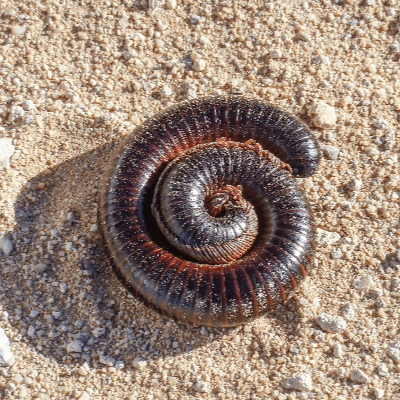
- Common Name: Millipede
- Kingdom: Animalia
- Phylum: Arthropoda
- Subphylum: Myriapoda
- Class: Diplopoda
- Orders: 16 Orders
- Species: 12,000+
14 Millipede Facts for Kids
- Millipedes are arthropods that have two jointed legs on most of their body segments, are members of the Diplopoda class and all living millipedes belong to either the Chilognatha or Penicillata subclass.
- Millipedes are not insects, while they look like your average creepy crawler they are not classified as an insect.
- It’s estimated that there around 12,000 species of arthropods, in 16 different orders, that are considered millipedes.
- Millipedes are found worldwide, they are on every continent except Antarctica.
- Most millipede species are detritivores, but a few species are omnivores.
- Millipedes don’t have a thousand legs, unlike the name would imply. The more common species of millipedes will have between 34 and 400 legs.
- Millipedes are generally slow and don’t have the ability to sting or bite a predator. Their main defense against a predator is the ability to curl up into a tight coil. Some species of millipedes can emit an awful smell as a secondary defense against predators.
- The Illacme plenipes is a siphonorhinid millipede that can have up to 750 legs, and that’s more legs than any other living animal on our planet.
- The spotted snake millipede (Blaniulus guttulatus) is considered a pest and can damage root crops, such as sugar beets.
- The xenobolus carnifex is a spirobolidan millipede and considered a household pest in Sri Lanka and South India.
- The yellow-banded millipede (Anadenobolus monilicornis) has been observed being crushed by birds and the birds rubbing the secretions on their wings. The theory is birds use these secretions as an insect repellant.
- The yellow-spotted millipede (Harpaphe haydeniana) can naturally produce hydrogen cyanide was in danger. Hydrogen cyanide is a very poisonous chemical compound, it was even used as a chemical weapon in World War 1.
- The Pneumodesmus newmani is an extinct millipede species that is believed to be one of the first animals land animals that could breathe oxygen.
- Extracted fluids from the Spirobolus bungii millipede has been shown to inhibit cancer cell growth in humans.
Millipede Pictures

A picture of an adult Giant African millipede.Credit: San Diego Zoo

A picture of a common millipede next to a penny.Credit: Diana Pounds

A picture of the apheloria-whiteheadi millipede.Credit: Paul Marek
Additional Resources on Millipedes
- Millipedes – Explore this Iowa State University web page to discover more awesome things about millipedes.
- Millipede – Britannica – Find more wonderful facts about millipedes on the Britannica website.
- Millipede – Wikipedia – Learn more about millipedes and the Diplopoda class on the Wikipediam website.
